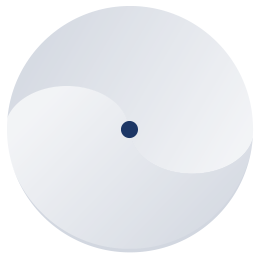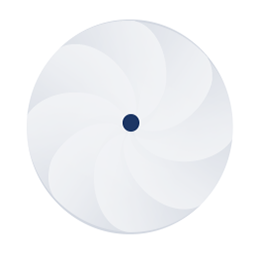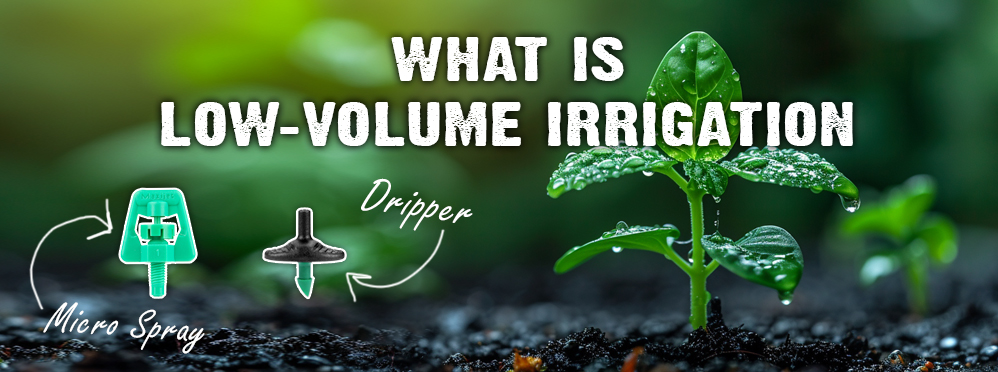TRADITIONAL IRRIGATION VS LOW-VOLUME IRRIGATION
When you think of traditional irrigation, it likely conjures images of old-fashioned, metal impulse sprinklers, or oscillating, hose-fed sprinklers that you have to move around the yard. Or you may envision the black plastic sprinklers sold by your local big box hardware store. And before some of these, a watering can or hose may have been employed to make sure flowers and plants stayed alive. Fortunately for you, times have changed. It’s now easier, cheaper, and greener to water your flowerbeds, gardens, shrubs, and trees. Today, low-volume irrigation is being used to save time, water, and money. And Mister Landscaper is leading the way. Below we’ve shown just a few of the advantages of low-volume irrigation over traditional irrigation.
MISTER LANDSCAPER LOW-VOLUME IRRIGATION USES UP TP 80 LESS WATER THAN TRADITIONAL IRRIGATION!
TRADITIONAL IRRIGATION
A single traditional sprinkler head can use up to 144 gallons of water per hour.
A traditional underground irrigation system can be expensive and difficult to install. It often requires hiring a professional contractor.
With traditional sprinklers, over watering and run-off are much more likely. Over watering can lead to drowning and soil erosion.
Hand watering using a watering can is time and labor intensive. A single gallon of water weighs nearly 8.5 pounds. Multiply that by the number of trips to the faucet and back, and a romantic notion has suddenly become quite the task.
Hand watering using a hose can be a frustrating chore when you consider uncoiling, removing kinks, dragging from place to place, and finally recoiling.
LOW-VOLUME IRRIGATION
A single Mister Landscaper Micro Spray Stake Assembly uses only 10 GPH. A complete Mister Landscaper system can use up to 80% less water.
Mister Landscaper low-volume irrigation is DIY-friendly and easily connects to any outdoor water faucet. There is no complicated installation process. There is no gluing and there are no special tools required.
Low-volume Micro Spray and Drip irrigation delivers the water more efficiently to the root zone, leading to happier healthier plants and less potential waste.
Mister Landscaper low-volume irrigation is fast and easy to install. Be up and running in under 30 minutes. Also, with a timer, you never need to worry about watering again.
Low-volume irrigation is an Earth-friendly practice that also helps save you money.
- Exempt from most watering restrictions-check with local watering authorities.
Drip Irrigation
What Is It?
Drip Irrigation is a term often used synonymously with low-volume irrigation. The reality, however, is that drip irrigation is a subgroup of low-volume irrigation. It gets its name from the fact that it does what it says: it drips. Depending on region, drippers may also be called emitters. Drippers, adjustable drippers, and drip tubing all emit small amounts of water from tiny orifices and deliver it directly to a plant’s root zone. The following is NOT an exhaustive review of drip irrigation, its uses, and kinds. It is meant to be a general overview–a starting point.Ideal Applications?
Drippers are hugely versatile in that they are perfect for small jobs, yet can still be used in larger, more demanding situations. Here are just a few ideal applications: Potted plants, hanging baskets, row gardens, tree rings, raised beds, and stand-alone plants and shrubs. But these are just the beginning. Don’t be afraid to get creative. There are no rules.
Water Usage?
Depending on the kind of drippers you choose, water usage can be anywhere from a half gallon of water per hour all the way up to ten gallons per hour. That said, generally speaking, expect to use between one half to two gallons per hour in most applications.
Kinds Of Drippers?
There are several different kinds and styles of drippers available from Mister Landscaper. It’s important to understand the differences, capabilities, and advantages of each when designing a low-volume irrigation system. Below are images and short descriptions to help give you a better understanding.
PC Drippers
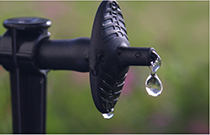
PC or pressure compensating drippers control water output regardless of the water pressure in a particular line. This helps maintain consistency from dripper to dripper and plant to plant.
Adjustable Drippers

Adjustable drippers can be turned on and off, and can be adjusted to deliver a 1 GPH drip all the way up to a delicate 10 GPH 8-stream spray. These drippers are adjusted by rotating the head. These drippers are not pressure compensating. If too many are on a single line, more water will be deliverd from the first drippers than from those that are at the end.
Standard Drippers
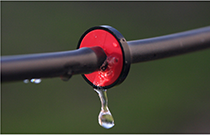
Standard drippers can be a great addition to any low-volume irrigation system. But be aware, they are not pressure compensating.
Drip Tubing
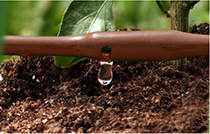
Drip tubing has pressure compensating drippers placed every foot. Each dripper delivers the same amount of water regardless of where it is in the line.
Anatomy Of A Dripper
Though there are multiple kinds and styles of drippers, they all function in a similar way. Water must enter. It must be slowed down (some amount of pressure reduction). And finally it must exit. To accomplish this, most drippers employ some type of labyrinth (turbulent flow) system (Fig. A). Note that just because some pressure reduction does occur, not all drippers are labeled “pressure compensating”.
When a dripper is labeled “pressure compensating”, it uses a diaphragm in conjunction with the turbulent flow system (Fig. B). This diphragm adjusts to pressure fluctuations in the line.
In addition to standard and pressure compensating drippers, there are adjustable drippers. While adjustable drippers do not have a traditional labyrinth and do not have a diphragm, the overlapping construction of the threaded parts creates turbulent flow and thereby reduces pressure (Fig. C). Tightening and loosening the threaded top decreases and increases flow.
The Advantage Of Pressure Compensating Drippers
As stated above, pressure compensating drippers regulate the pressure from dripper to dripper. Water output is managed and stays the same at each dripper regardless of PSI fluctuation or elevation changes. This feature is particularly important when running very long lines with lots of drippers or when a line of drippers is run uphill away from the water source. In the example below you can see what happens when non pressure compensating drippers are used in this scenario: Water delivered at the beginning of the line nearest the water source is greater than what is being delivered at the end of the line.
What is Micro Spray Irrigation
What is It?
Micro spray irrigation is a form of low-volume irrigation which uses small diameter tubing and small orifice micro spray heads to help limit water output. Additionally, Mister Landscaper utilizes flow controllers and on/off valves to further limit water consumption. Micro sprays, in many ways, sound like what they are: small sprinklers. Bigger is not always better, as in the case of sprinklers. Micro sprays deliver water in a way that is useful to your plants: The droplets land gently, delivering water more directly to the rootzone.
Ideal Applications
Micro sprays really can be used to water just about everything in your landscape and garden. Varied patterns, spray angles, and adjustable flow rates mean the creative possibilities are endless. To get you started, here are a few ideal applications for micro spray irrigation: flower gardens, vegetable gardens, trees, shrubs, and all your landscape plants and flowers.
Water Usage
Micro spray stake assemblies with flow controllers are designed to only use ten gallons of water per hour. This, of course, can be adjusted down at the individual stake by the use of the included valve. If the flow controller is removed, water output will change with variations in pressure, number of micro sprays on a line, and changes in elevation down the length of a line.
Micro sprays have a very simple water delivery system. Whether it’s a one-piece, spinner, or swap top, water travels through the threaded stem of the micro spray then out the orifice. Water then contacts the head of the micro spray, resulting in a spray pattern (Fig. A). Spinners also function in this way. The only difference is the spinning head. Water is forced out the channels, causing the head to spin (Fig. B)
Kinds of Micro Sprays
Micro sprays can be divided into three different categories: One-piece micro sprays, spinners, and three-in-one swap tops. While water is delivered to and from each micro spray in a similar way, what makes a micro spray head unique is the pattern it creates. Because of this, Mister Landscaper has pioneered new and innovative ways to get even more flexibility from a single micro spray head. Below is a breakdown of each group.
Micro Sprays
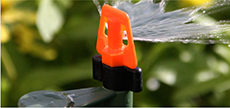
Micro Sprays each offer their own unique stationary spray pattern. When an application calls for a single, specific pattern, these micro sprays will get the job done each and every time.
Spinners
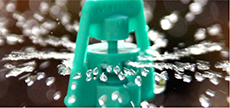
Spinners are a micro spray with a center rotating spinner. Water pressure causes the spinner to spin, which then sprinkles the water in a complete 360º spray pattern. Spinners are great general purpose micro sprays that work equally well for a number of different irrigation applications.
Swap Tops
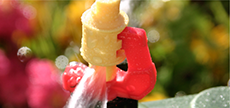
Mister Landscaper has taken micro spray flexibility to a new place with the three-in-one swap top. As the name indicates, each micro spray actually offers three unique spray patterns. By simply rotating or removing the swap top a new spray pattern is achieved.
Anatomy Of A Micro Spray

Three-in-one swap tops operate in the very same way that one piece micro sprays and spinners do. The difference here is the addition of a swappable top. By rotating the top, end over end, or removing the top altogether, a new pattern is achieved (Fig. C).

One important feature of Mister Landscaper micro spray technology is the incorporation of flow controllers. While flow controllers are not part of the micro spray head, they do play an important role in water delivery. Flow controllers keep water usage at each stake to only ten gallons of water per hour. They have an internal diaphragm (Fig. D) that prevents the output of too much water.
The Advantage Of Flow Controllers
Each micro spray stake assembly from Mister Landscaper comes with a flow controller. Much like pressure compensating drippers, flow controlled micro sprays are more consistent and more efficient. To get the maximum number of stake assemblies on a single line or to install stakes uphill, moving away from the water source, it is critical to use flow controllers. The example below shows what can happen without them.

Drip Irrigation or Micro sprays
Getting started with Mister Landscaper is easy to do whether you choose drip irrigation, micro sprays, or a combination of the two. All you need is an outdoor water faucet and a little bit of time—typically less than an hour. That said, there are differences between drip irrigation and micro sprays that one should be aware of to design the very best system possible. Below are the lists of advantages and potential disadvantages to each.
Drip Irrigation Pros and Cons
Drip Irrigation Pros
Drippers tend to have a lower profile compared to micro sprays. They are not as conspicuous in the landscaping.
On average, a dripper uses only 1-2 gallons of water per hour. That is less than a micro spray.
Drippers can be used where some micro sprays cannot, as in the case of smaller potted plants and hanging baskets.
Drippers can be more efficient at watering individual plants.
Drip Irrigation Cons
Because by design drippers emit such a small amount of water, it can be difficult to see or know when a dripper is clogged. In some cases a plant may go into wilt or die before a problem is detected.
Drippers are not as easily unclogged as micro sprays.
Because they emit less water, an increased number of drippers are potentially needed to cover the same amount of area as a single micro spray. This could lead to increased installation time and cost.
Micro Spray Irrigation Pros and Cons
Micro Spray Irrigation Pros
Micro sprays are significantly more adjustable than drippers, from size and shape of spray pattern to gallons per hour used.
A single micro spray can easily cover multiple plants, while a dripper is much more limited in scope.
Because micro spray patterns are clearly visible, detecting a clog or a problem with the line is much easier.
Clogged micro sprays and flow controllers are easily cleaned for simple, hassle-free maintenance.
Micro sprays can cool plants and efficiently water them at the same time.
Micro Spray Irrigation Cons
Micro sprays have a larger profile and may be more visible in the landscape.
Micro sprays are not ideal for certain applications, like small potted plants and hanging baskets.
Soil Type Considerations
One thing to consider when choosing between drip irrigation and micro spray irrigation is soil type. Some soils are better suited for drippers, and some soils are better suited for micro sprays. Here is a simple jar test to help determine your soil type. Begin by taking a soil sample from the area you wish to irrigate. Take that dirt and fill a glass jar approximately halfway (Fig. A). Now fill the jar the rest of the way with water (Fig. B). Finally, place the lid and shake the jar well (Fig. C).

Now let the jar rest for 24 hours. Once the soil settles, the results can be classified in one of three ways: sand, loam, or clay. Use the chart below (Fig. D) to help determine your soil type and which kind of irrigation might be best for your situation. Note: Contact your local county extension agency for best watering practices in your area.

Application
Clearly, there are some applications where one type is more suitable than the other. But, there are a number of applications where either is perfectly acceptable. At the end of the day, it’s all about creativity. Know and understand the benefits of each micro spray and dripper and design a system that works for you and your garden or landscape.
Micro Sprays
With micro sprays, one of the big advantages is coverage. With a single starter kit (MLK-81) you can cover up to 250 square feet! But within that coverage there is a lot of flexibility, especially in the way of spray pattern selection. Some of the micro sprays are great for large and small area general purpose watering. But there are several micro sprays designed with specific purposes in mind (Fig. E).

Note the various options and their potential uses.
Large Full-Circle Spinner
Ideal for general purpose watering in large open areas.
320º Fan Spray
Suitable for general purpose watering in small areas.
End Strip Spray
Used in small confined areas or to limit overspray in adjoining spaces.
Small Full-Circle Spinner
Ideal for general purpose watering in more compact areas.
180º Half-Circle Spray
General purpose. Idealy used near the edges of landscapes and gardens.
Center Strip Spray
Highly directional. Perfect for long, narrow areas of landscaping.
360º Stream Flat Spray
Large spray pattern is great for broad, open areas.
165º Half-Circle Spray
Half-circle spray keeps water off siding and side walks.
360º Stream Down Spray
Ideal for rose gardens. Keeps water off foliage and petals.
90° Quarter Circle Spray
Ideal for use in tight interior 90º corners.
Drippers
Drippers tend to be a bit more specialized. Use them in places where a micro spray may be overkill or where you prefer a lower profile. Mister Landscaper Add-A-Drippers (MLD-AAD) are perfect for creating tree rings (Fig. F). Adjustable dripper stakes (MLD-STA) are excellent for potted plants of all sizes (Fig. G). PC (pressure compensating) drippers (MLD-.5PC, MLD-PC1, MLD-2PC) are great for hanging baskets and general use (Fig. H). And drip tubing works well in row gardens (Fig. I).


Whatever your irrigation needs, Mister Landscaper is sure to have a solution. And help is always just a phone call or email away (863-439-3200, Email Mister Landscaper)
